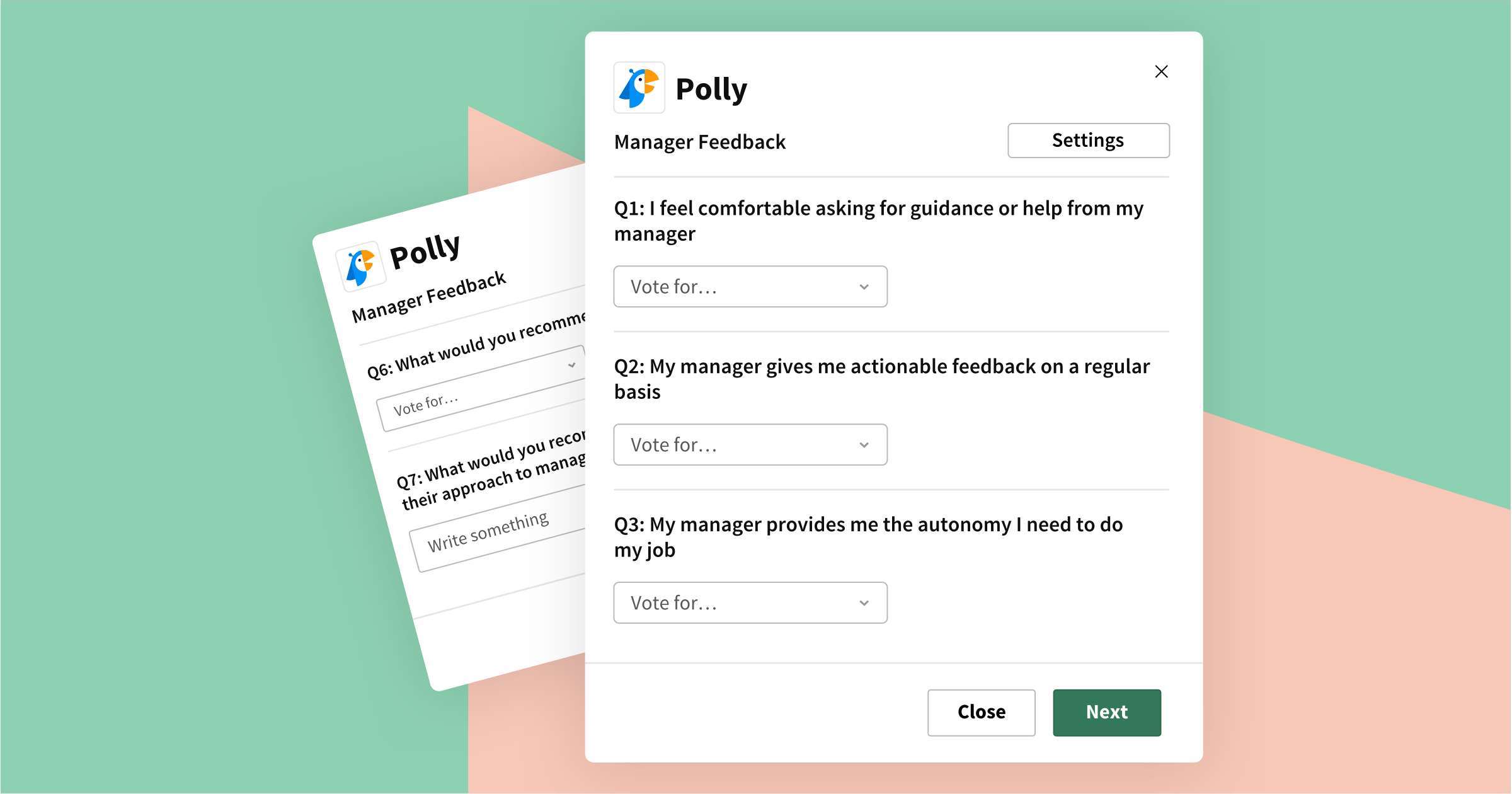Telling your boss that you don’t like the way they do things is daunting, even if it’s a completely necessary conversation to have. It’s no wonder why employees feel resistant to giving manager feedback, given the relationship involved.
Still, manager feedback remains one of the best ways to get an insight into how your leaders are truly received. Honest criticisms and praise help you uncover challenges before they become big issues, and allow you to congratulate managers for doing an incredible job at supporting their teams.
While giving manager feedback sounds hard, it’s something we should definitely be empowering our teams to take advantage of.
In this guide, we’ll share:
- What manager feedback is
- Why manager feedback is helpful
- How to encourage your team members to give manager feedback
Let’s jump in and explore why encouraging manager feedback should be a priority at your organization, and how to make it happen.
What is manager feedback?
Manager feedback covers any ideas, concerns, thoughts, and feelings you share with your manager about how they work or your professional relationship. It’s like employee feedback, but specifically directed at your manager.
This feedback can happen in a formal setting, like a performance review, or an informal way, like expressing thanks in a team meeting for help with a new project. Often manager feedback is given anonymously so direct reports feel they can be transparent, but it’s not uncommon for people to feel comfortable to raise issues directly either.
Some great constructive feedback examples for managers include:
- 👍 Thank you for all your hard work on planning this project. I know it didn’t go to plan, but I really appreciated the clear direction you were able to give me.
- 📁 Not having access to the files until this week meant the project was delayed. Thank you for explaining why this happened, and I hope we can find a way to prevent it in the future.
- 🏖️ Thanks for always taking your vacation time, [Name]. It reminds me of the value of work-life balance and encourages me to use mine too.
- 🧩 You’re great at problem solving, which is a huge benefit when working on a project like [Project Name]. We had some roadblocks, but I’m glad we were able to navigate them together.
- 👋 I’m used to working with managers that are more hands-off. I can see the benefits of your management style, but please know that I will always check in if I need help or encounter a problem.
- 🤗 I know how hard it is to lead a team through a round of layoffs. I appreciate your honesty throughout the process.
These constructive and positive feedback examples go to show there are many different points you can praise a manager on, and areas where you might want to raise a concern or highlight a challenge that you’ve now resolved. There are countless moments in our working lives where we’ll encounter a challenge or want to give feedback, and we shouldn’t shy away from offering it to managers and leaders.
Why manager feedback is helpful
For most people, giving feedback to your boss can feel uncomfortable or awkward — even if it’s said in a positive light or needs to happen. Knowing the positive impact that manager feedback can have is a great way to help soften those nerves and encourage more constructive criticism to happen.
Some of the most valuable impacts of giving manager feedback include:
- Promoting honest feedback across the organization
- Identifying management styles or habits that may need addressing (e.g., micromanaging)
- Promoting employee recognition for great work
- Supporting leaders to become good managers
- Encouraging values like accountability, transparency, and trust
- Helping to spot the signs of burnout and low employee morale
- Raising opportunities for professional development and training
- Helping to avoid miscommunication in the workplace
- Making working together feel effortless
- Showing support to direct reports and team members that need it
- Upholding your company culture and values
It’s not always easy to share feedback with a manager, but the benefits are huge. Whether it’s a major issue that needs addressing, a minor miscommunication error, or praise that you think they deserve to hear, promoting manager feedback is a must-have in forward-thinking organizations.
How to encourage team members to give manager feedback
We know people are often reluctant to give feedback to or about their manager. So how do we fix that? Here are six ways you can encourage and empower your team members to share more honest manager feedback.
1. Create a feedback culture 🌎
To really embrace the power of employee feedback, you need to make it an integral part of your culture. Design a culture that makes honesty a key value and prompt for feedback at every opportunity — from onboarding right through to the moment an employee leaves.
This is something we live at Polly, with our systems of continuous feedback. These systems help us to promote feedback, tackle issues, surface ideas, and grow at a pace that wouldn’t be possible without the honesty and transparency that a feedback culture creates.
2. Provide your team members with guidance 📔
Throughout an employee journey there will be both positive feedback and negative feedback to share, but it’s important to get the tone and delivery right. That’s why giving your team members guidance on how to give and receive feedback is essential.
Share advice with team members on how to give effective feedback, including critical feedback. Offer specific examples or scenarios that might apply, so they can visualize what to say and how to say it. Offer training not only on providing feedback, but receiving it too.
3. Run anonymous surveys 👻

One of the best ways to gain valuable insights into what your managers are really like is with anonymous surveys. Thanks to the anonymity, this is a more inclusive way of gathering criticism and praise, and allows you to get more relevant upward feedback.
Our Manager Feedback template is ideal for teams that want to encourage more anonymous feedback, more often. Schedule this poll (known as a “polly”) on a regular basis to prompt direct reports to give insights into their employee experience and what they think of their manager. It’s anonymous, so your team members are free to give their honest thoughts — knowing that not even the human resources team can see who said what.
4. Openly request feedback ❔
While not everyone is comfortable sharing feedback when asked directly, it’s still useful to get into the habit of asking. Openly requesting feedback creates opportunities to consider what’s working and what isn’t, even if the direct report doesn’t want to share anything in the moment.
Good chances to ask for feedback include one-on-one meetings, like performance reviews, or in team meetings if you’re an open and outgoing group. Avoid putting someone on the spot in front of the entire team though — this is unlikely to elicit any meaningful feedback. Instead, read the atmosphere of the team and understand when to ask for manager feedback directly.
5. Encourage people to share feedback often 📣
Most work environments don’t feature natural reminders to give and receive feedback, so we need to create them. A great way to do this is to use automation and feedback apps to help you check in on a regular basis.
Use Polly to schedule regular feedback polls and surveys to understand your employees’ thoughts and feelings. Running your surveys more often gives you more data, which you can then compare over a period of time to identify trends, challenges, and opportunities.
6. Share the outcomes of feedback ✔️
Employees won’t give feedback that they feel isn’t listened to. Show your team members that you take their concerns and ideas seriously, and share some of the positive outcomes of their past feedback.
Where it’s relevant, let the feedback-giver know privately how you’re dealing with their situation. Publicly, share how your organization is taking steps forward and improving for the better. Mention that you’ve booked training sessions on management and leadership skills, that you’re supporting the professional development of your leadership team, and that mentoring is available to anyone that would like it. Not only does this demonstrate transparency and build trust, but it also helps encourage employee engagement and future feedback.
Make manager feedback part of your culture
An environment where everyone feels comfortable to give and receive feedback should be your end goal. Use the ideas above to help foster a culture where feedback is expected, listened to, and welcomed by all.
If you’re ready to find a better way to encourage feedback at your organization, make Polly your co-pilot. Our feedback and coaching features give you fresh ways to engage your team members and motivate them to get involved, so you all benefit from the power of employee feedback.

Written by Nicola Scoon
Nicola Scoon is a freelance writer that's passionate about employee engagement and better workplace experiences. She draws on her experience in internal communications to help companies create content that empowers, encourages, and motivates people to create better experiences for all.




/Internal%20Comms%20Fun%204.png)
/Ask%20questions%20fun%204.png)





